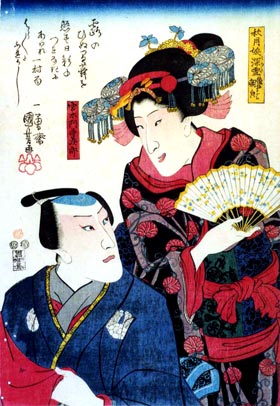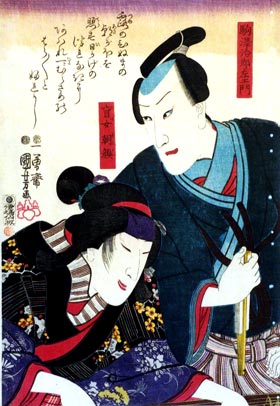| ASAGAO NIKKI |
| Play title | Sh˘utsushi Asagao Banashi |
| Authors | Chikamatsu Tokuz˘ Nagawa Harusuke I ("Keisei Tsukushi no Tsumagoto") Nishizawa Ipp˘ ("Eiri Sh˘setsu Asagao Monogatari" Yamada-no-Kakashi ("Sh˘utsushi Asagao Nikki" |
| History |
"Asagao Nikki", or "The Tale of the Morning Glory" in English, based on a famous k˘dan entitled "Asagao" (Morning Glory"), has a rather complicated story. It was written for the first time by Chikamatsu Tokuz˘ at the beginning of the 1800s but was never staged. A new script, based on Chikamatsu Tokuz˘'s unstaged work, was written by Nagawa Harusuke I and was staged under the title "Keisei Tsukushi no Tsumagoto" in the 1st lunar month of 1814 at the Kado no Shibai [casting]. The play was subsequently adapted to the puppet theater, in 1832 with Yamada-no-Kakashi's "Sh˘utsushi Asagao Nikki", from which version later Kabuki plays were derived, like Nishizawa Ipp˘'s "Eiri Sh˘setsu Asagao Monogatari", which was staged in the 8th lunar month of 1848 at the Ichimuraza [casting], or "Sh˘utsushi Asagao Nikki", which was staged in the 11th lunar month of 1855 at the Kado no Shibai [casting]. |
| Structure |
Yamada-no-Kakashi's "Sh˘utsushi Asagao Banashi" was made up of 5 acts. A normal production of "Asagao Nikki" is made up of Act I ("Fireflies Hunt on the Uji River"), Act III/Scene 1 ("At the Ebisuya, an Inn in Shimada") and Act III/Scene 2 ("The ďi River Bank"). |
| Key words | Sewamono Koto Asagao |
| Summary |
Fireflies Hunt on the Uji River While viewing the fireflies on the Uji river, handsome Miyagi Asojir˘ fell in love with Miyuki, the daughter of Akizuki Yuminosuke, a powerful samurai, when a breeze blew a poem that he wrote into her boat. Before parting, he wrote a poem about the morning glory on her fan. Events conspire to keep the two apart, but they meet again as they both are about to sail from the port of Akashi. Asojir˘ hears someone singing the poem about the morning glory and is overjoyed to find that it is Miyuki. She decides to part from her father and go with Asojir˘ to Kamakura, but before she can go from her boat to his, the wind blows them apart. She tosses the fan with the poem to Asojir˘ as a keepsake. At the Ebisuya, an Inn in Shimada Longing for Asojir˘, weeping has caused Miyuki to go blind. She has fled her home and begs for offerings as a blind musician. In the most famous scene of the play, the blind Miyuki, who calls herself Asagao, encounters Asojir˘, who has become a fine samurai and is now called Komazawa Jirozaemon, in an inn in Shimada, but he cannot reveal his identity to her. He leaves money, some medicine to cure her blindness and an explanation. The ďi River Bank Learning that she has lost Asojir˘ yet again, she pursues him to the ďi river. She is about to throw herself into the river when she is given the medicine to recover her sight, but this is only possible with the sacrifice of the life of the loyal Tokuemon. She recovers her sight and beauty and can finally be united with Asojir˘. Source: Earphone Guide website |
| Comments |
Miyuki and Asojir˘ are household names in Japan, the chief figures in a romance that started one summer evening in Ky˘to, when at a fire-fly festival on the river their boats came together, and they fell in love at first sight, exchanging fans on which they had written extemporaneous verse. They plighted their troth, but stern samurai business kept Asojir˘ in another part of the country, and Miyuki, neglected and forlorn, wept so much that she became blind, and started to wander about the country with her nurse trying to find her faithless lover. The finest scene is that in which the blind girl plays the koto, or long harp-like instrument, at an inn where her lover is stopping. Asojir˘ and an elderly samurai are on a special mission, and his companion thinks only of his duty, and allows for no delinquency or soft-heartedness on the part of Asojir˘, who is overcome when he finds the blind koto player, brought in by the innkeeper to amuse them, is no other than his own Miyuki. All he can do is to give her some remembrance and a sum of money which he leaves with the innkeeper. By these tokens Miyuki knows that she has been in the presence of Asojir˘, and half distracted she runs to the river to overtake her fleeing lover, who has been obliged by his taskmaster of a travelling companion to hasten on his way. The river has risen, and the ferrymen will not take any more passengers across. There are many wet eyes in the audience, for the parting of young lovers never fails to appeal to the tender-hearted in all countries the sun shines upon. The playwright knew that his audience would be disappointed were the lovers never to meet again, and the sympathetic innkeeper makes a gash in his body in order that he may provide the blind maid with a liberal portion of his blood, whereby her eyesight is miraculously restored. Later she is united with Asojir˘, and all ends well. ZoŰ Kincaid in "Kabuki, the Popular Stage of Japan" |
| Trivia |
"Asagao Nikki" gave rise to a craze for patterns incorportating the morning-glory (asagao) on clothes, fans,
hair ornaments, etc. |
 |
 |
|
The actors Ichikawa Danjűr˘ VIII and Band˘ Shűka I playing the roles of Asojir˘ and Miyuki in the "Akashi no Ura Funawakare" scene of the drama "Eiri Sh˘setsu Asagao Monogatari", which was staged in the 8th lunar month of 1848 at the Ichimuraza (print made by Utagawa Kuniyoshi) |
The actors Ichikawa Danjűr˘ VIII and Band˘ Shűka I playing the roles of Komazawa Jirozaemon (the new name of Asojir˘) and the blind Miyuki in the "Yadoya" scene of the drama "Eiri Sh˘setsu Asagao Monogatari", which was staged in the 8th lunar month of 1848 at the Ichimuraza (print made by Utagawa Kuniyoshi) |
|
|
| Contact | Main | Top | Updates | Actors | Plays | Playwrights | Programs | Links | FAQ | Glossary | Chronology | Illustrations | Prints | Characters | Derivatives | Theaters | Coming soon | News |